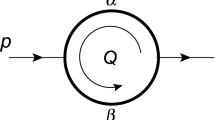Abstract
The well-known Baker–Campbell–Hausdorff theorem in Lie theory says that the logarithm of a noncommutative product \(\text {e}^X \text {e}^Y\) can be expressed in terms of iterated commutators of X and Y. This paper provides a gentle introduction to Écalle’s mould calculus and shows how it allows for a short proof of the above result, together with the classical Dynkin (Dokl Akad Nauk SSSR (NS) 57:323–326, 1947) explicit formula for the logarithm, as well as another formula recently obtained by Kimura (Theor Exp Phys 4:041A03, 2017) for the product of exponentials itself. We also analyse the relation between the two formulas and indicate their mould calculus generalization to a product of more exponentials.
Similar content being viewed by others
Notes
We assume \({\text {ord}}(A+B) \ge \min \{{\text {ord}}A,{\text {ord}}B\}\) and \({\text {ord}}(AB)\ge {\text {ord}}A + {\text {ord}}B\) for any \(A,B\in {\mathcal {A}}\), and \({\text {ord}}A = \infty \) iff \(A=0\).
Indeed, \(\tau ^{-1}(i)\) is the position in \({\underline{n}}\) of \(\omega _i\), the ith letter of \({\underline{a}}\,{\underline{b}}\).
In Écalle’s work, the initial motivation for the definition of alternality and symmetrality is the situation when \({\mathcal {A}}\) is an algebra of operators (acting on an auxiliary algebra) and each \(B_n\) acts as a derivation: in that case, the \(B_{[\,{\underline{n}}\,]}\)’s satisfy a modified Leibniz rule which involves the shuffling coefficients, whence it follows that MB is itself a derivation if M is an alternal mould, and an algebra automorphism if M is symmetral. Here we do not assume anything of that kind on \({\mathcal {A}}\) and the \(B_n\)’s but rather follow the spirit of “Lie mould calculus” as advocated in [20].
References
Baumard, S., Schneps, L.: On the derivation representation of the fundamental Lie algebra of mixed elliptic motives. Annales Mathématiques du Québec 41(1), 43–62 (2017)
Behtash, A., Dunne, G.V., Schäfer, T., Sulejmanpasic, T., Ünsal, M.: Complexified path integrals, exact saddles, and supersymmetry. Phys. Rev. Lett. 116, 011601 (2016)
Bonfiglioli, A., Fulci, R.: Topics in Noncommutative Algebra—The Theorem of Campbell, Baker, Hausdorff and Dynkin. Lecture Notes in Mathematics, vol. 2034. Springer, Heidelberg (2012)
Bouillot, O., Écalle, J.: Invariants of identity-tangent diffeomorphisms expanded as series of multitangents and multizetas. In: Resurgence, Physics and Numbers, pp. 109–232, CRM Series, 20, Ed. Norm., Pisa (2017)
Couso-Santamaría, R., Schiappa, R., Vaz, R.: On asymptotices and resurgent structures of enumerative Gromov–Witten invariants. Commun. Numer. Theor. Phys. 11, 707–790 (2017). arXiv:1605.07473
Couso-Santamaría, R., Mariño, M., Schiappa, R.: Resurgence matches quantization. J. Phys. A Math. Theor. 50, 145402 (2017)
Dynkin, E.B.: Calculation of the coefficients in the Campbell-Hausdorff formula (Russian). Dokl. Akad. Nauk SSSR (N.S.) 57, 323–326 (1947)
Dillinger, H., Delabaere, E., Pham, F.: Résurgence de Voros et périodes des courbes hyperelliptiques. Annales de l’institut Fourier 43(1), 163–199 (1993)
Écalle, J.: Les fonctions résurgentes, Publ. Math. d’Orsay [vol. 1: 81-05, vol. 2: 81-06, vol. 3: 85-05] (1981, 1985)
Écalle, J.: Cinq applications des fonctions résurgentes. Publ. Math. d’Orsay, pp. 84–62 (1984)
Écalle, J.: Introduction aux fonctions analysables et preuve constructive de la conjecture de Dulac. Actualités Math, Hermann (1992)
Écalle, J.: ARI/GARI, la dimorphie et l’arithmétique des multizêtas: un premier bilan. Journal de Théorie des Nombres de Bordeaux 15(2), 411–478 (2003)
Fauvet, F., Foissy, L., Manchon, D.: The Hopf algebra of finite topologies and mould composition. Annales de l’Institut Fourier 67(3), 911–945 (2017)
Gaiotto, D., Moore, G.W., Neitzke, A.: Wall-crossing, Hitchin systems, and the WKB approximation. Adv. Math. 234, 239–403 (2013)
Kimura, T.: Explicit description of the Zassenhaus formula. Theor. Exp. Phys. 4, 041A03 (2017)
Kontsevich, M.: Resurgence and Quantization. Course given at IHES, Paris in April 2017
Matone, M.: An algorithm for the Baker–Campbell–Hausdorff formula. J. High Energy Phys. 05, 113 (2015). arXiv:1502.06589
Menous, F.: Formal differential equations and renormalization. In: Connes, A., Fauvet, F., Ramis, J.-P. (eds.) Renormalization and Galois theories, IRMA Lect. Math. Theor. Phys., vol. 15, pp. 229–246 (2009)
Novelli, J.-C., Paul, T., Sauzin, D., Thibon, J.-Y.: Rayleigh-Schrödinger series and Birkhoff decomposition. Lett. Math. Phys. 108, 18 (2018). https://doi.org/10.1007/s11005-017-1040-1
Paul, T., Sauzin, D.: Normalization in Lie algebras via mould calculus and applications. Regul. Chaotic Dyn. 22(6), 616–649 (2017)
Reutenauer, C.: Free Lie Algebras, London Mathematical Society Monographs, vol. 7. Clarendon Press, New York (1993)
Sauzin, D.: Initiation to mould calculus through the example of saddle-node singularities. Rev. Semin. Iberoam. Mat. 3(5–6), 147–160 (2008)
Sauzin, D.: Mould expansions for the saddle-node and resurgence monomials. In: Connes, A., Fauvet, F., Ramis, J.-P. (eds.) Renormalization and Galois Theories. IRMA Lectures in Mathematics and Theoretical Physics, vol. 15, pp. 83–163. European Mathematical Society, Zürich (2009)
Sauzin, D.: Introduction to 1-summability and resurgence. In: Mitschi, C., Sauzin, D. (eds.) Divergent Series, Summability and Resurgence. I. Monodromy and Resurgence. Lecture Notes in Mathematics, vol. 2153. Springer, Berlin (2016)
Schneps, L.: Double shuffle and Kashiwara–Vergne Lie algebras. J. Algebra 367, 54–74 (2012)
Thibon, J.-Y.: Noncommutative symmetric functions and combinatorial Hopf algebras. In: Asymptotics in Dynamics, Geometry and PDEs; Generalized Borel Summation, vol. I, pp. 219–258. CRM Series, 12, Ed. Norm., Pisa (2011)
Voros, A.: The return of the quartic oscillator. The complex WKB method. Annales de l’I. H. P. Section A tome 39(3), 211–338 (1983)
von Waldenfels, W.: Zur Charakterisierung Liescher Elemente in freien Algebren. Arch. Math. (Basel) 17, 44–48 (1966)
Acknowledgements
D.S. and Y.L. thank the Centro Di Ricerca Matematica Ennio De Giorgi and the Scuola Normale Superiore di Pisa for their kind hospitality, during which this work was completed.
Author information
Authors and Affiliations
Corresponding author
Additional information
Yong Li and Shanzhong Sun: Partially supported by NSFC (Nos. 11131004, 11271269, 11771303).
Rights and permissions
About this article
Cite this article
Li, Y., Sauzin, D. & Sun, S. The Baker–Campbell–Hausdorff formula via mould calculus. Lett Math Phys 109, 725–746 (2019). https://doi.org/10.1007/s11005-018-1125-5
Received:
Revised:
Accepted:
Published:
Issue Date:
DOI: https://doi.org/10.1007/s11005-018-1125-5



